5/7 – 21/9/2001

After a protracted border crossing, it was nightfall before we reached the town of Foz do Iguaçu. Next day, we drove the 20 km to the Brazilian side of the spectacular Iguaçu Falls.

We made the mistake of taking a picnic and were mugged by some very assertive coatis.


Next day, we crossed the border back into Argentina to view more of the 200 separate falls that make up the whole;


including by boat.

Back in Brazil, we drove north and then north-east for three days. We passed through Parana’s rolling countryside, with its fields of corn and wheat, into the State of Mato Grosso do Sul. At night, we stopped with the truckers at service stations.
On the fourth day we reached Poconé and headed down the Transpantaneira, the road that crosses the Pantanal – the world’s largest tropical wetland area. In our two days there, we explored the Pantanal on foot, by bike and on horseback. We saw many exotic birds

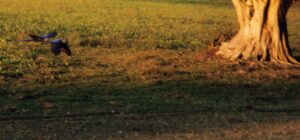

and some exotic cows.


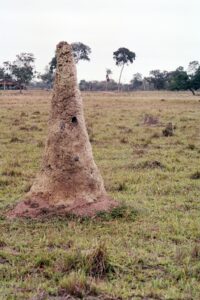
Back on the road, it took us three days to cover the 1,400 km to Brasilia; which was inaugurated as Brazil’s capital in 1960.
We camped for six nights at the city’s youth hostel; visiting the futuristic (for the 60s) congress and plaza,

with its modern sculptures,



and the spectacular concrete and glass cathedral.

We spent time with Joseph and Katarina,


a German couple who had been travelling for two and a half years in their 1957, 12.5 ton Mercedes truck.

They had started their journey in Australia.
Beatriz, the manager of the youth hostel, introduced us to her father, Sylvano, who asked his mechanic to look at the Landrover. He diagnosed the problem as a loose pin and faulty housing in the differential.

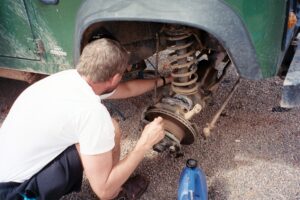
Val, the mechanic, had the parts flown in from Belo Horizonte, and changed the two front shock absorbers for good measure.
On our last day in Brasilia, Sylvano invited us to spend a day at his farm, 60 km outside of Brasilia, with him, Beatriz and their families.


Sylvano baked us a (homemade) pizza for dinner.
After our night at Sylvano’s, we started a 1,500 km drive east. The countryside became progressively greener. East of Santa Ines, we passed through a particularly lush valley.

Four days after leaving Brasilia, we reached the coast. We crossed the bridge onto Itaparica Island; passing palm-fringed beaches before taking the one-hour ferry ride

across the Baia de todos os Santos

to Salvador,


the capital of the State of Bahia.
After a day on the beach, we left Salvador on a wet morning. We drove north up the Linha Verde, a road lined with lush vegetation and coconut palms. We camped on a long, sandy beach; which, judging from the number of beach umbrellas, must be a busy resort in high season.
Further up the coast, we took the ferry across the Rio São Francisco do Penedo to the fishing village of Lagoa Azeda; where we camped for two nights among the palms on the beach. A 2 km walk up the beach, was a stretch of multi-coloured soapstone cliffs.

After passing through Recife, we stopped for a day at Olinda;
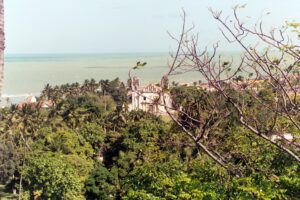


and at Praia do Seixas at Cabo Branco; with its small fishing fleet.

![]()

Next day, we started the 2,000 km drive to Belem on badly potholed roads; with detours to avoid stretches of even worse asphalt, and yet another set of brake pads – jolted out by one of the potholes.
Belem is a port and the gateway to the Amazon River. A friendly manager of a service station south-east of the city had given us the contact details of a shipping agent and we booked a place on a boat due to leave the next day.
After a morning’s shopping to stock-up for the six-day trip to Manaus, the agent led us to the dock,

and we parked alongside a wall of containers. The ‘boat’ was a simple flat-decked barge, close to the water and with no side walls.

After dark, the dockers loaded 30 trucks and containers onto the barge.

We were tucked into a small space between them.


A small tug was lashed to the rear of the barge

and, at 22.00, we set off.
On our first day on the river, the Amazon was several miles wide in places interspersed with narrow channels. Mostly, the banks were mangrove backed by what looked like dense forest. Dotted along the banks were wooden houses on stilts; with jetties jutting into the river.
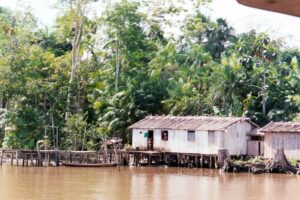


Further upstream, there were long stretches of cleared forest with grassy patches for grazing cows.




We led a simple life as we moved steadily against the flow of the river.





Sometimes, local people, including children, would lash their dug-out canoes to the side of the barge and clamber aboard. They would either beg money or try to sell us shrimps or cane alcohol.
Our only fellow ‘passengers’ were Eduardo,

a Brazilian trucker who was accompanying his truck and refrigerated container, and his wife, Claudia.
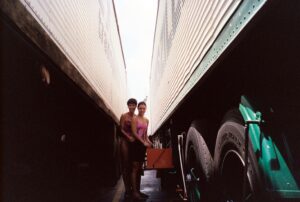

We entertained one another for dinner.


On the evening of our fifth day, the tug pushed the barge onto a sandy bank adjacent to the dock at Manaus. We walked up the beach with Eduardo and Claudia for a few beers at a local bar; before returning to the barge for our final night.
At dawn the next day, the tug pushed the barge to the small dock and we drove ashore. We took a taxi to the Venezuelan embassy to apply for a visa. Eduardo arranged for us to camp in a lorry park close to the centre of town.
We picked up our visas next morning and spent the rest of the day in town – the highlight being our visit to the famous Manaus Opera House.



We made a late morning start for our drive north and camped at a service station close to the entrance to the Waimiri Atroari indigenous reserve. The first 120 km of the next day’s drive was through the reserve – one of the few stretches of undisturbed native forest in this part of the Amazon. We crossed the line of the equator, 50 km after we had left the reserve.
Next day, we had more problems with our rear shock absorbers and stabilisers. A mechanic in Boa Vista charged us $4 to make the repair.
We crossed into Venezuela next morning; stopping at Santa Elena to change money and eat lunch. Continuing north, we climbed onto the plateau of the Gran Sabana; with its rolling hills, grassland and distant Tepuis. We stopped for two nights at Rio Sarapan – a camping area close to a small river with waterfalls and bathing areas on the river bed of smooth, red jasper.


The only down side were the vicious bites of the puri-puri flies.
As we continued north, we descended from the Gran Sabana and back into humid, tropical forest. We passed through the shanty towns of a gold and diamond mining area; stopping early afternoon at a small campground on the Río Cuyuni, south of El Dorado. The campground owner was raising an orphaned jaguar cub.


We spent the next day at Cuidad Bolivar on the banks of the Orinoco River. The city is named after Simon Bolivar, who was born in what is now Venezuela and who liberated the northern part of South America from Spanish colonial rule.
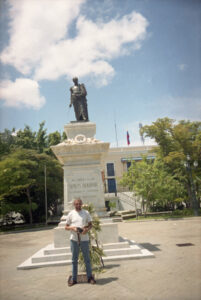
We reached the coast at Barcelona and Puerto La Cruz; before turning east to spend a couple of days on the beach at Playa Vallecito.




We spent some time on the Paria Peninsula on the Caribbean Sea, within sight of the island of Trinidad and Tobago, before turning back west and inland to the Parque nacional El Guácharo; famous for its large limestone cave.


The cave is home for hundreds of thousands of Guacharos – nocturnal birds that feed on the oil-laden fruit of palm trees that grow nearby. At dusk, we sat at the mouth of the cave to see, and hear, the guacharos emerging.
After returning to Playa Vallecito for a few more days, during which time we changed the drive shaft on the Landrover, we drove south-west; by-passing Caracas, to Guanare.

From there, we drove south to Barinos and then north-west back into the Andes.
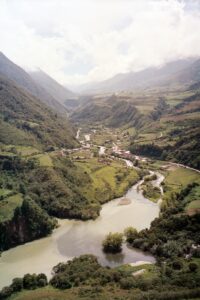
We stopped in Santo Domingo for a coffee at the Hotel Trucha Azul; where we met Carlos, a local artist.

As well as showing us his studio and other local sites, Carlos directed us to a campsite by a mountain stream.

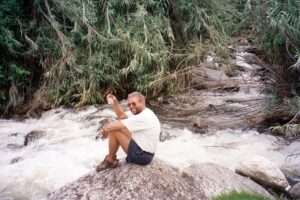
Next morning, we drove a few steep and winding kilometres up into the Sierra Nevada National Park to camp at Laguna Mucubaji. From there, it was a four-hour hike

to the top of a mountain that overlooks the lake.

After a cold night (the lake was at an altitude of 3,600 metres), we continued west

to Merida; where we collected the tickets for our flight home from a local travel agent.
We crossed the Pico el aguila, at 4,000 metres the highest pass in Venezuela, before climbing further to Tuname; after which the paved road ended. It was barely passable by the time we passed through Niquitao on our way to Boconó; where we camped at Laguna los Cedros.
Next day, we descended the western slopes of the Andes; joining a well-made road at Trujillo which connected with the main road towards Caracas.
We checked into a Caracas hotel for our final week. On the third day, we loaded the Landrover into a container at the port at La Guiara and three days later, we took the overnight flight back to London.

The Falls are spectacular and wildlife varied, including the termite mounds.
Danielle reallyed enjoyed the modern sculptures.
What kindness shown helping you repair the truck and being invited to a farm.
Lovely tropical beaches and the Amazon River looks memorable and a break from the driving and a chance to make new friends.
Very happy having the map for this stretch, or I would never have figured out your route. Those soapstone cliffs are a wonderful colour, they remind me a bit of some of the coast we saw in Portugal last time. Beautiful reds, pinks and ochres – contrasting with all the green. As for your adventure on the barge, I cannot imagine being on a thing like that for five or six days solid, and only one other couple….. but yout apéro on deck looked quite convivial! I do like the houses on stilts, as if they would walk away given a chance :-).
My favourite photo of this set, though, is the very last one. I can’t quite explain it: it is a patchwork, but the patches are not flat, and then there are the shadows from the clouds and the perspective of the field in the centre which draws you in. Maybe Hobbits could live there!
Anyway, thank you for letting me travel with you – it has given me so much pleasure. I am sure we shall talk again about these photos, and the adventure! You have been so good keeping the images safe, and I realise how much work has gone into recreating a full account of a trip so long ago.
Very envious (again), especially of the Pantanal visit. I remember you talking about the Amazon barge, but didn’t remember it being six days. Good to hear you got so much friendly help everywhere.